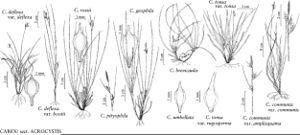Carex brevicaulis
Bull. Torrey Bot. Club 40: 547. 1913.
Plants densely to loosely cespitose; rhizomes horizontally spreading to ascending, brown to reddish-brown, 0–10 mm, slender or stout. Culms 2–19 cm, strongly scabrous distally; bases and remnants of old leaves slightly fibrous. Leaf-blades pale green, exceeding stems, 1.3–2 (–3.5) mm wide, herbaceous to coriaceous, glabrous abaxially, scabrous to papillose adaxially. Inflorescences with both staminate or pistillate spikes; peduncles of basal spikes erect, elongate, slender; peduncles of staminate spikes 1.7–8.5 (–21) mm; proximal nonbasal bracts scalelike, usually equaling or shorter than inflorescences, rarely longer. Spikes: proximal pistillate spikes 2–5 (basal spikes 1–3); cauline spikes usually separated, with 1–6 perigynia; staminate spikes 5.7–14.4 × 0.9–2.1 mm. Scales: pistillate scales reddish-brown with narrow white margins, ovate, 3.2–6 × 2–2.2 mm, equaling or exceeding perigynia, apex acute to acuminate (short-awned in some basal spikes); staminate scales lanceolate, 4.1–5.1 × 2 mm, apex acute to obtuse. Anthers 2–2.5 mm. Perigynia pale bright green, finely 12–15veined near base, globose, round in cross-section, 3.5–4.8 × 1.7–2.1 mm; beak straight, pale green, not strongly 2-edged, 0.6–1.6 mm, ciliate-serrulate, apical teeth 0.2–0.5 mm. Stigmas 3. Achenes brown, globose to obovoid, round in cross-section, 1.9–2.4 × 1.6–2 mm. 2n = 28.
Phenology: Fruiting late Mar–late Jun.
Habitat: Dry, open, sandy or rocky slopes, cliffs, and dunes
Elevation: 0–90 m
Distribution

B.C., Calif., Oreg.
Discussion
Selected References
None.
Lower Taxa
"shortened" is not a number.
